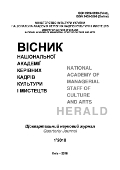PRIORITIZATION OF ORGANIZATIONAL IDENTITY INDICATORS IN QAEMSHAHR MUNICIPALITY
DOI:
https://doi.org/10.32461/2226-3209.1.2018.178825Анотація
Abstract. Organizational identity is a model of beliefs, values and feelings that forms in a special
interaction between individuals and their peripheral environment in the context of organizational culture. The purpose of this study is to prioritize organizational identity indicators in Qaemshahr Municipality. This research is applied in terms of purpose and is descriptive in terms of data collection. In this research, collection method was library and field design and the standard questionnaire was organizational identity measurement which Cronbach's alpha was 0.81. The collected data were analyzed using descriptive statistics and inferential statistics. The results showed that in organizational identity components, correlation, loyalty and similarity indices are in the first to third priority respectively.
Keywords: Organizational Identity, Membership or Solidarity, Loyalty or Organizational Support,
Similarity or Perception of Common Characteristics.
Посилання
Boroumand, Zahra (2007). Management of Organizational Behavior. 15th edition. Tehran. Payam Noor
Publications.
Hafez Nia, Mohammad Reza (2004), Introduction to Research Method in Humanities, 10th Edition,
Tehran: Samt.
Dehkhoda, Ali Akbar (2010). Dehkhoda Dictionary: Unique Treasures of Persian Literature and Literature
in CD format, Tehran. Tehran University Press.
Rastegar, Abbasali, Jangholi, Mahmoud, Heydari, Faezeh, Heydari, Hamed (2012). Investigating the Role
of Spiritual Leadership in Organizational Identity, Public Management Research: 5 (16).
Gholipour, Aryan, Pourezat, Ali Asghar, Mohammadi, Fereshteh (2011), Explaining the internal and
external factors affecting the organization of identity organization in government agencies, Public
Administration: 3 (7), 149-166.
Gharehcheh, Manijeh and Dawboian, Monirah (2011). Staff loyalty in interaction with customer service
loyalty. New Marketing Research. First year. No. 3. P. 46.
Albert, S. and Whetten, D. A. (1985) "Organizational Identity in L.L. Cummings & M.M. Staw" (Eds).
Research in Organizational Behavior, Vol. 7, No. 3, Pp. 263-267.
Ashforth, R. E., & Mael, F. A. (1996). Organization identity and strategy as a context for the individual,
Advances in Strategic Management, 13, 19-64.
Bagozzi, R. P., & Yi, Y. (1988). On the evaluation of structural equation models, Journal of the Academy
of Marketing Science, 6(1), 74–94.
Cornelissen, J. P.; Haslam, S. A., & Balmer, J. M. (2007). Social identity, organizational identity and
corporate identity: towards an integrated understanding of processes, patterning and products. British
Journal of Management, 18(1), 1-16.
Dahlla, R. (2008). The influence of organizational identity, image and reputation on organizational strategic
response to institutional pressures. Unpublished doctoral dissertation, York University, Toronto.
Dutton, J.; Dukerich, J., & Harquail, C. V. (1994). Organizational images and membership commitment,
Administrative Science Quarterly, 34, 239-263.
Fehsenfeld, C. (2011). Founders' sense making and sense giving behaviors effect on the organizational
identities of new charter schools. Unpublished doctoral dissertation, university of Massachusetts Boston.
Foote, N.N. (1951) "Identification as the Basis for a Theory of Motivation". American sociological Review,
Vol. 16, Pp.14-21.
Gioia D. A., & Thomas, J. B. (1996). Identity, image and issue interpretation: sense making during
strategic change in academia, Administrative Science Quarterly, 41(3), 370–403.
Hatch, M. J. and Shultz, M. (1997) "Relations between Organizational Culture, Identity and Image".
European Journal of Marketing, Vol. 31, No. 5/6, Pp. 356- 65.
Lee, S.M. (1971) "An Empirical Analysis of Organization Identity". Academy of Management Journal.
Vol. 14, Pp. 213-226.
Pratt, M. G., & Foreman, P. O. (2000). Classifying managerial responses to multiple organizational
identities, Academy of Management Review, 25(1), 18-42.
Olins, W. (1995) "Guide Til Design of Identiter", Dansk Design Center, Kobenhaven.
Ravasi, D., & Schultz, M. (2006). Responding to organizational identity threats: exploring the role of
organizational culture. The Academy of Management Journal Archive, 49(3), 433-458.
Ravishankar, M. N., & Pan, S. L. (2008). The influence of organizational identification on organizational
knowledge management (KM), Omega, 36, 221-234.
Tajfel, H., & Turner, J. C. (1979). An integrative theory of inter-group conflict, in W.C. Austin & S. Worchel (Eds.), The Social Psychology of Inter-Group Relations, 33– 47, Monterey, CA: brooks/Cole.
##submission.downloads##
Номер
Розділ
Ліцензія
Автори, які публікуються у цьому журналі, погоджуються з наступними умовами:
1. Автори залишають за собою право на авторство своєї роботи та передають журналу право першої публікації цієї роботи на умовах ліцензії Creative Commons Attribution License, котра дозволяє іншим особам вільно розповсюджувати опубліковану роботу з обов'язковим посиланням на авторів оригінальної роботи та першу публікацію роботи у цьому журналі.
2. Автори мають право укладати самостійні додаткові угоди щодо неексклюзивного розповсюдження роботи у тому вигляді, в якому вона була опублікована цим журналом (наприклад, розміщувати роботу в електронному сховищі установи або публікувати у складі монографії), за умови збереження посилання на першу публікацію роботи у цьому журналі.
3.Політика журналу дозволяє і заохочує розміщення авторами в мережі Інтернет (наприклад, у сховищах установ або на особистих веб-сайтах) рукопису роботи, як до подання цього рукопису до редакції, так і під час його редакційного опрацювання, оскільки це сприяє виникненню продуктивної наукової дискусії та позитивно позначається на оперативності та динаміці цитування опублікованої роботи.

